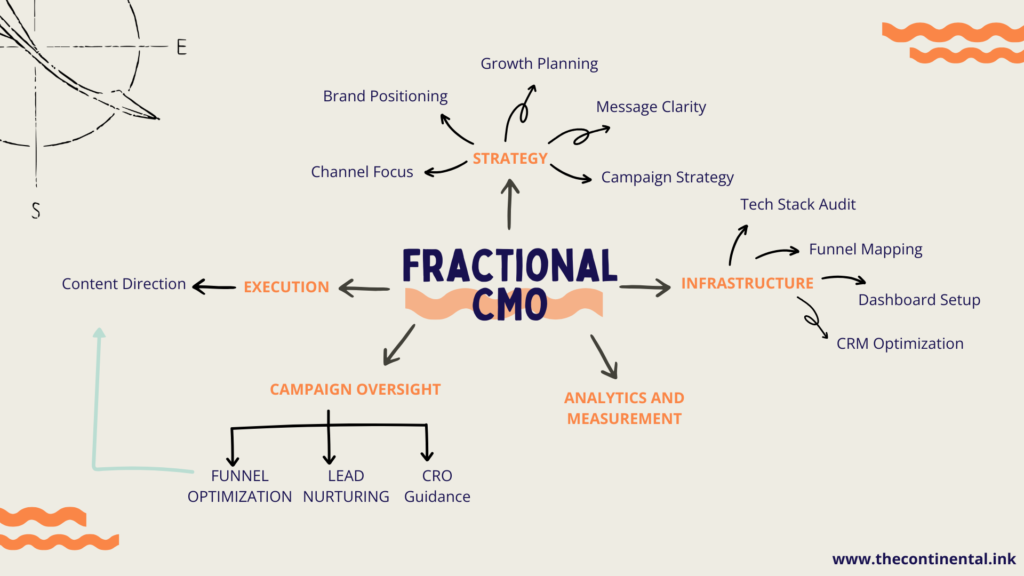Spoiler: it’s not just strategy decks and Slack messages.
If you’re thinking about hiring a fractional CMO, chances are things feel… messy.
Leads are stalling. Messaging is scattered. Marketing is busy, but not effective. And deep down, you know: without senior leadership, growth stays random.
A fractional CMO promises clarity, focus, and actual traction—without the $250K salary or long onboarding curve. But here’s what most companies get wrong:
They bring one in… and have no idea what “success” should look like.
So progress feels fuzzy. The team stays reactive. And momentum never really builds.
This guide fixes that.
We’ll walk you through the first 90 days of a high-impact fractional CMO engagement—what gets done, what moves the needle, and how to tell if it’s actually working.
If you’re a founder, operator, or head of sales wondering, “Will this hire actually change the game?”— this is your answer key.
TL;DR: What Happens in the First 90 Days with a Fractional CMO?
In the first 90 days, a fractional CMO will:
Week 1: Onboard fast, set KPIs, and align on business goals
Weeks 2–4: Audit marketing channels (SEO, paid, email, content), analyze performance data, and identify quick wins
Weeks 5–8: Build a strategic marketing roadmap, align budget, and implement systems
Weeks 9–12: Launch priority campaigns, train the team, and deliver early results
You can expect strategic clarity, improved execution, and measurable traction—without hiring a full-time executive.
First, What Is a Fractional CMO? (And What They're Not)

A fractional CMO is a part-time marketing executive who plugs directly into your leadership team. They’re not an agency. They’re not a strategist who sends decks and ghosts. They’re a hands-on leader who owns outcomes—brand, demand, pipeline, and all.
They come in to:
- Build a real strategy (not a wishlist)
- Lead internal and external teams
- Prioritize ruthlessly
- Turn marketing from a cost center into a growth engine
Think of it like renting a CMO brain and leadership arm—without adding overhead.
Month 1: Diagnose, Align, and Identify Leverage
Your first month with a fractional CMO should feel fast, focused, and uncomfortably honest.
This isn’t the time for vision boards or vanity metrics. It’s about understanding where your growth is blocked—and what needs to shift now.
Week 1: Download the Business
Forget the fluffy onboarding doc. Week one is a diagnostic sprint.
A high-impact fractional CMO will:
- Meet key stakeholders — founder, sales, ops, marketing (if it exists)
- Review what’s live — website, CRM, ad accounts, analytics dashboards
- Extract growth constraints — revenue targets, deal cycles, team bandwidth
- Pressure-test the positioning — does your messaging actually resonate with buyers, or just make sense internally?
If your CMO isn’t asking uncomfortable, specific questions by Day 3? You didn’t hire a leader—you hired a yes-man.
Weeks 2–4: Audit & Assess
Now it gets tactical. This is where your CMO starts going through everything to find what’s actually driving (or stalling) growth.
Expect a full audit across:
- Website — Is it converting or confusing? Do you have a clear narrative, or corporate filler?
- Funnels — Where do leads leak? What happens after someone clicks "Book a Call"?
- Paid + Organic — What’s bringing in qualified pipeline vs. expensive distractions?
- Email + CRM — Is your database segmented, nurtured, and tracked—or just a ghost town?
- Messaging — Is your content saying something unique, or could it belong to any of your competitors?
But this isn’t just an audit for the sake of optics.
Your CMO is looking for leverage points—the 2–3 areas where focused effort could unlock exponential impact.
Your Deliverables by Day 30
- A prioritized breakdown of what’s working, what’s wasting time, and what’s missing
- A quick-win roadmap—fast, tactical moves that drive immediate clarity or conversions
- A strategic hypothesis for how marketing should actually drive revenue (not just impressions or MQLs)
This first month isn’t about checking boxes. It’s about building a shared understanding of what matters, what’s broken, and where the upside lives.
Month 2: Build the Strategy. Install the Systems.
Now that the gaps are exposed, it’s time to architect a marketing engine that can scale under pressure. No duct tape. No dashboards that look pretty but mean nothing. This is where your fractional CMO earns their keep.
Weeks 5–8 are about structure, speed, and clarity.
Not “let’s make a content calendar.” This is high-leverage decision-making—prioritizing ruthlessly, assigning ownership, and setting up the systems that make consistent execution inevitable.
1. The Marketing Roadmap (Built for Execution, Not Optics)
Forget the 50-slide decks that gather dust. This is a living, prioritized roadmap designed to drive action across 30, 60, and 90+ day windows.
Your roadmap should cover:
- Immediate wins — high-ROI experiments, conversion fixes, or sales-enablement assets that unlock near-term pipeline
- Strategic growth plays — SEO, content, outbound, brand—mapped to buyer intent and business model
- Channel focus — not “be everywhere,” but be effective where it counts
If the roadmap doesn’t help your team decide what to do this week, it’s not a roadmap—it’s a distraction.
Want this kind of roadmap tailored to your growth goals? Book a 1:1 consultation and get access to our Bulletproof Marketing Roadmap—a proven framework we use to help founders break through plateaus and build scalable engines that don’t rely on guesswork.
2. Systems That Make Execution Scalable
Strategy without systems = bottlenecks. Your CMO’s job isn’t just to think—it’s to install the infrastructure that gets ideas to market fast.
Expect:
- Real dashboards — Clear KPIs tied to outcomes (revenue, pipeline velocity, CAC), not just Google Analytics fluff
- Workflow upgrades — Templated campaign briefs, automated approvals, and defined sprint cycles
- Budget tracking — What's funded, what's frozen, and how ROI is measured across every channel
- Ops alignment — Make sure marketing, sales, and customer success are operating on a shared timeline and feedback loop
If your marketing still runs on “just checking in” emails and Slack threads, you don’t have a system. You have chaos with a calendar invite.
3. Role Clarity That Eliminates Drag
Execution stalls when no one knows who’s doing what—or worse, when everyone assumes someone else is.
Your CMO should deliver a team accountability map that clarifies:
- Who owns what, from campaign execution to CRO to attribution
- What success looks like, with defined metrics for internal roles and agency partners
- How handoffs happen, so strategy flows cleanly into execution without dropped balls
If internal marketing reports to five different people—or if contractors are guessing what “done” looks like—your CMO needs to step in and fix it. Fast.
The job isn’t to micromanage. It’s to remove ambiguity. That’s what leads to speed—and results.
Month 3: Execute. Win Fast. Refine.
This is where strategy turns into velocity.
By now, the roadmap is locked, the systems are in place, and the team knows the mission. Your fractional CMO steps fully into the operator seat—leading execution, generating early traction, and turning marketing into a growth engine that moves the needle.
Launch Priority Campaigns (Not Random Tests)
Weeks 9–12 aren’t for spray-and-pray ideas. This is about focused, high-impact execution that solves the biggest bottlenecks fast.
Expect campaigns that:
- Activate high-intent leads already sitting in your pipeline
- Fix leaky funnels with CRO or retargeting that actually converts
- Refresh key messaging to reduce bounce and boost conversion on high-traffic pages
- Turn LinkedIn (or your best-fit platform) into a real acquisition channel—not a content graveyard
The goal isn’t flawless execution—it’s calculated action that drives a signal. The faster you get market feedback, the faster you win.
Level Up the Team (Fast)
Great fractional CMOs don’t just drive results—they build internal capability.
If you’ve got marketers, designers, or sales enablers in place, this is where mentorship happens in real time. Expect:
- Sharper briefs that lead to better execution
- Smarter reviews that teach—not just critique
- Cross-functional clarity that aligns marketing with sales, product, and leadership
Your team should walk away more confident, more focused, and more capable. Otherwise, you’ve hired a doer—not a leader.
Iterate in Real Time
Campaigns go live. Metrics move. The market responds. Your CMO adjusts.
This loop should run tight:
- KPIs are monitored daily—especially in the first 72 hours post-launch
- Wins and misses are surfaced with context, not excuses
- Adjustments are made weekly—not quarterly
This is where average CMOs overthink, and great ones outlearn the market.
Agility is a seriously underrated growth strategy. The best results come from shipping early, measuring honestly, and adjusting fast.
👉🏻 Bonus!
Want a quick-glance summary of what your fractional CMO should be delivering in the first month? Use this visual to track progress—or hold your marketing lead accountable.

Save this image or drop it into your onboarding doc—it’s built for alignment and action.
How to Know It’s Actually Working
Marketing doesn’t always scream when it’s broken—but it whispers when it starts working.
In the first 90 days, you won’t have a full pipeline yet. But you should feel—and see—movement. Signals that the machine is turning on.
Early Signals of Traction
These are the “green shoots”—leading indicators that things are clicking:
- Shorter feedback loops between marketing and sales (less confusion, more clarity)
- Higher lead quality—not just more leads, but better ones
- Tighter execution—less scrambling, fewer dropped balls
- Strategic clarity—no more “what are we even doing?” meetings
If your team suddenly sounds aligned in the weekly standup? That’s not a fluke. That’s momentum.
Leading vs. Lagging KPIs
Here’s a simple breakdown of what to track—and what it tells you:
| Metric Category | What to Track | What It Tells You | What to Do With It |
|---|---|---|---|
| Early Traction Signals | Shorter feedback loops, clearer communication, aligned meetings | Teams are aligned, less guesswork, more strategic focus | Clarify ownership, maintain regular syncs, reinforce shared goals |
| Lead Quality & Velocity | Higher-fit leads, faster funnel movement, less sales friction | Targeting and messaging are landing with the right audience | Refine ICP, optimize offers, align with sales insights |
| Leading KPIs (Real-Time) | Conversion rates, email engagement, retargeting, CRM accuracy | Funnel and campaigns are starting to generate results | Double down on high-performing segments, pause weak channels |
| Lagging KPIs (Revenue Impact) | Marketing-sourced revenue, CAC vs. LTV, direct/branded traffic | Marketing is influencing revenue and brand equity | Report ROI, secure buy-in, inform long-term growth strategy |
| Execution Clarity | Clear priorities, visible progress, aligned next steps | Team is focused and working from strategy, not chaos | Sustain momentum, share wins, reinforce direction every sprint |
If none of these are moving? It’s not “too early”—it’s a signal that something’s off.
Track Signal, Not Just Activity
It’s easy to confuse marketing motion with marketing progress. But the right CMO won’t let you.
You should know:
- What’s being done
- Why it matters
- What it’s producing (even if it’s early)
- And what’s next—based on data, not hope
Early wins build confidence. Strategic wins build momentum. And together, they create the compounding engine you actually hired for.
Tips to Maximize Your First 90 Days with a Fractional CMO
Want to make the most of your fractional CMO investment? Here’s how to set the stage.
- Empower decisiveness: Don’t hire senior talent and then make them beg for decisions. Give access. Clear roadblocks. Let them lead.
- Set expectations, not wishlist: Your CMO isn’t a magician. Agree on priorities and be ruthless about scope creep.
- Streamline your stack: Stop using six tools to manage one funnel. Your CMO should help consolidate—so things actually get done.
- Share feedback early: This is a partnership, not a vendor relationship. Good CMOs crave data, reactions, and market signals. Don’t hold back.
Bonus tip: If your CMO isn’t proactively creating clarity, asking hard questions, and making things easier for your team in the first 30 days—they’re not the right fit.
Common Pitfalls (And How to Avoid Them)
No engagement is friction-free. Here are the most common 90-day landmines—and how to sidestep them:
| 🚩 Problem | 💡 Fix |
|---|---|
| Leadership misalignment | Weekly syncs with stakeholders. Keep goals visible and shared. |
| Unclear roles | Clarify ownership across internal + external teams. Write it down. |
| Resistance from legacy staff | Anchor on results. Share early wins. Invite—not impose—change. |
| Unrealistic timelines | Your CMO can’t fix a decade of bad marketing in 3 weeks. Give space to build, not just react. |
Frequently Asked Questions
Long enough to build and lead. Most engagements last 6–12 months, but the sweet spot depends on your growth stage and goals. A good fractional CMO should work themselves out of a job—or into a bigger one.
Nope. Fractional CMOs work for:
- Seed-stage companies that need early traction
- Mid-sized teams without in-house strategy
- Post-Series A orgs that need a marketing rebuild
- Service businesses ready to stop relying solely on referrals
Agencies execute. Fractional CMOs lead. If you don’t know what to build, don’t outsource it yet.
Absolutely. Great CMOs don’t stop at MQLs—they partner with sales to drive the full pipeline.
- Access to tools and analytics
- A list of current marketing assets
- Clarity on business goals
- A point person to help move things fast
Early wins can happen within 30 days. Full traction usually takes 60–90, depending on your baseline.
The Right 90 Days Sets the Next 900
If you’re hiring a fractional CMO, you’re not looking for incremental change. You’re looking for clarity, speed, and strategic firepower.
In the right hands, 90 days is enough to:
- Expose your biggest leaks
- Align your team around a real strategy
- Launch campaigns that actually generate momentum
In the wrong hands? It’s just another expensive reset—and your team will feel it.
So if you’re serious about turning marketing into a true growth engine, don’t guess your way through it.
Start with a roadmap. Start with leadership. Start strong.
Book a 1:1 consultation to access our Bulletproof Marketing Roadmap and see exactly how a fractional CMO can accelerate your next 90 days—and beyond.


